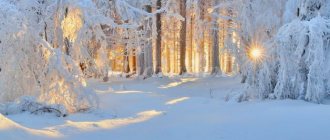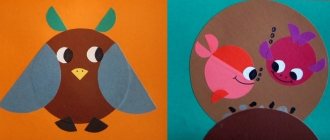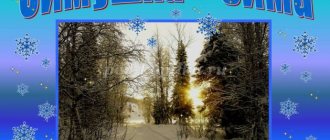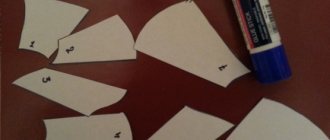Project: “What do we know about water?”
Introduction.
Project type: information and research.
Duration: medium duration (November - April).
Subject of research: properties of water.
By number of participants: group.
During the period of preschool childhood, the child discovers the natural world, with the help of which the child’s learning process takes place in an emotional and practical way. Every preschooler is a little explorer, discovering the world for himself with joy and surprise. The child strives to be active. That is why such types of activities as observation and project are the closest and most natural for a child - a preschooler. The project, being one of the forms of joint activity, is a technology for the development of independence, investigative behavior, cognitive and creative activity of children.
The first substance that a child gets acquainted with with pleasure is water. It gives the child pleasant sensations, develops various receptors and provides almost unlimited opportunities to explore the world and himself in it. Playing with water is one of the most enjoyable ways to learn.
Relevance.
Walking outside with the children in the fall, we began to look at the puddles and became interested: “What kind of water is there?” What happens to it in nature, how water affects the life of plants and people; why do you need to wash your hands and bathe? What properties does water have? Draw children's attention to the fact that such a familiar object as water is fraught with many unknowns. Children need to instill environmentally conscious skills in everyday life, in particular, learn to use water carefully and economically. All this emphasizes the relevance of this project.
The goal of the project: to generalize and expand children’s knowledge and ideas about inanimate nature - about water.
Tasks:
- create conditions for the formation of cognitive interest in children,
- introduce children to the properties of water (taste, color, smell, fluidity),
- give an expanded understanding of the properties of snow, as one of the properties of water,
- clarify the importance of water for all living things,
— cultivate a sense of mutual assistance and accuracy when conducting experiments.
Expected result:
- expand and deepen children’s knowledge and ideas about the world around them, including water,
-develop cognitive skills through experimental activities,
- gain experience in humane treatment of plants and living beings,
- cultivate a caring attitude towards water.
Product of project activities: album of observations of planting growth; exhibition design: “We are experimenters.”
Project implementation stages.
Preparatory stage:
- Creation of an experimental laboratory in the group.
- Examination of illustrations related to an inanimate object - water.
- Selection of outdoor and speech games.
- Drawing up notes for thematic lessons in different sections of the program.
- Compilation and creation of experiments, experiments with water.
Research stage of the project (thematic planning of classes and experiments for the project).
| Chapter. Name. | Content. | Software tasks. |
| Getting to know your surroundings. “What do we know about water?” | Looking at the illustrations about water, formulate the topic of the lesson. While admiring the images of various bodies of water, try to understand what kind of water there is. Encourage children to experiment with water. Demonstrate experiments with water: “Water is a liquid” - pour and pour water into glasses. “The water is clear”, “Water has no taste” - brewing tea and chicory, compare with the taste of water. “Sinking - floating”, “Is it possible to drink melt water”, “Sinking - floating”. At the end of the experiments, wash your hands and draw the children’s attention to the fact that they need to wash their hands well and close the tap tightly - to save water. | Introduce children to the properties of water (taste, color, smell, fluidity). Clarify its meaning for all living things. Develop curiosity, thinking and speaking skills. Enter into the passive dictionary: sweet, bitter, sour, stinks, tasty, no smell, flows, moves. Foster respect for water. |
| Fiction. | Looking at books about water, illustrations, paintings, magazines. | Teach children to look carefully, react emotionally to what they see, and empathize. Conversation in an accessible form. |
| A comprehensive lesson on familiarization with the environment (“You can’t do without water”), experimentation and application (“Boat at Sea”). | In this lesson, show children in what form water exists. In an accessible form, conduct a conversation about the seasons: what natural phenomena are characteristic of each season. Conduct experiments with snow: “Snow melting (in a mitten) and the second experiment is snow melting in the palm. Also with snow: determining the purity of snow and water (melting on plates). Using illustrations, consider rain, raindrops, ice floes in water, frozen water. | Clarify the signs of winter, form an aesthetic attitude towards winter phenomena; Show children in what form water exists - experiments with water, snow. Develop creative imagination and strengthen skills in working with waste material. Develop feelings of empathy, responsiveness and the ability to work in a team. |
| Visual activity. | Drawing "It's snowing"; "Magic Rain" Finger gymnastics: “Rain, rain, more fun (hands up, finger movements); drip, drip, don’t be sorry! (point your index finger to the sides); just don’t get us wet (rectangle above your head); Don’t knock on the window in vain - spray more in the field (throwing your fingers out of your fists forward), the grass will become thicker (use your hands to imitate grass). | Arouse interest in the image of snow. Learn to draw using non-traditional techniques. Learn to reflect seasonal changes in drawings. Focus on a sheet of paper, be able to draw vertical lines with the end of a brush. Cultivate accuracy when working with paints. |
| Conversation. "Cleanliness is the same as beauty." | Learn to take care of your appearance on your own. If necessary, use water, adjust the temperature of the water in the tap. Conduct experiments with water coloring; with coloring celery stalks; evaluate the properties of water that gives life to living things. | Instill in children the rules of personal hygiene. |
Games for the project.
| Types of games | Content | Program tasks |
| Speech. “Give me a word.” | Water floats on water (ice). Quietly, quietly, as if in a dream, it falls to the ground: (snow). Everything is falling into the clearing, into the meadow: (snowball). There is a snowy figure nearby, it’s a girl: (snow maiden). As if in a fairy tale, as in a dream, the whole earth was decorated with snow: (snow)… | Learn to guess simple riddles, activate conjugate pronunciation, fingerprinting. |
| Low mobility game. "Stream." | Children stand in pairs, one after another, hold hands and raise them, forming a hoop. One child, the leader, goes through the gate and chooses any player from the pair, leading him along to the end of the corridor. The child left without a partner becomes the leader. | Develop attention, act by imitation. |
| Outdoor game. “Here, frogs.” | In the middle of the site, draw a large circle or place a thick cord in the shape of a circle. A group of children is located along the edge of the circle, the rest sit on chairs placed on one side of the area. With those sitting on chairs, say the words: “Here are the frogs along the path, jumping with their legs outstretched, qua-kva-kva, ka-kva-kva, jumping with their legs outstretched. Children standing in a circle jump like frogs. At the end of the words, children sitting on chairs clap their hands (scare); frogs jump into the “swamp” - jumping over the line - squat down. | Teach children to copy the movements of the inhabitants living in the swamp. Follow the teacher’s instructions, accompanied by recitation of poems. Creating a joyful, cheerful atmosphere. |
| Outdoor game. "Bubble". | The teacher dips a paper tube or straw into soap foam and blows bubbles. When the bubble comes off the tube, the teacher blows on it so that it flies around the room. The children are happy and try to catch the bubbles. | Create a cheerful, cheerful mood. Get children interested in making a soap solution and the resulting result. Activation of conjugate pronunciation. |
| Outdoor game. "Sun and Rain." | Children squat down behind chairs located at some distance from the edge of the playground and look “through the window” (into the hole in the back of the chair). Educator: “There is sunshine in the sky”: children run and walk. At the signal “Rain”: they run to their places and sit down behind the chairs. Do this several times. | Develop children's imagination and activity in play. Activation of conjugate pronunciation, listening and hearing skills. |
| Outdoor game. "Crucian carp and pike." | One child is a pike. The rest - “pebbles” - form a circle; others - “crucian carp” - swim inside the circle. At the signal “pike” (quickly runs into the circle) - catch crucian carp. Crucians hide from pike behind pebbles. The pike catches those who did not have time to hide behind the stones. Repeat 3-4 times | Learn to follow the rules of the game. Understand that one fish catches another. Looking at illustrations about the underwater world. Activation of oral pronunciation, fingerprinting. |
Event plan.
November.
- Select and study methodological literature on the topic of the project.
- Looking at illustrations, books, pictures on the topic with children.
December.
- Replenish the development environment:
- selection of illustrations, books on the topic;
- compiling card files of riddles, proverbs, sayings;
— design of experiments with water;
— preparation of equipment for experiments;
— implementation of project activities.
4. Conducting a lesson to familiarize yourself with the environment: “What do we know about water?”
5. Drawing “It’s snowing.”
January.
- Carrying out the game “Give me a word”.
- Looking at paintings and illustrations.
- Prepare information for parents on the topics: “Experiment in kindergarten”, “Entertaining experiences and experiments for preschoolers”, “Why should we save water?”
- Execution of project activities.
February.
- Implementation of project activities.
- Carrying out outdoor games: “Frogs”, “Soap Bubbles”.
- View illustrations about seas and bodies of water.
March.
- Execution of project activities.
- Outdoor game "Sun and Rain".
- Application "Boat at sea".
- Design of the photo exhibition “We are experimenters.”
- Lesson “You can’t do without water.”
April.
- Lesson: “What do we know about water?”
- Experiments.
- Drawing "Magic Rain".
- Outdoor game: “Crucian carp and pike.”
- Conversation (in an accessible form): “Cleanliness is the same as beauty.”
Experiments for the project.
“Snow melting” (1st experiment).
Goal: to bring children to the understanding that snow melts from any heat source. Develop logical thinking, horizons, and conjugate pronunciation.
“Snow melting” (2nd experiment).
Goal: to develop children’s knowledge about natural phenomena in winter. Learn to observe, see cause-and-effect relationships, and draw joint conclusions.
“Is it possible to drink melt water?”
Goal: to show that even the most seemingly clean snow is dirtier than tap water. Develop logical thinking, cultivate curiosity.
"Properties of water."
Purpose: to show the important property of water - to give life to living things.
"Water Transparency"
opaque." Cultivate curiosity and attention.
"Sinks - floats."
Purpose: to let children understand that metal sinks in water, but wood does not.
"The water is clear."
Purpose: to introduce children to some of the properties of water. Develop the ability to compare and draw appropriate conclusions. Activate conjugate pronunciation and dactyl reading.
"Colored celery."
Purpose: to introduce children to the physical phenomenon - absorption. Draw children's attention to the fact that even such a familiar object as water is fraught with many unknowns. Activation of conjugate pronunciation, reading with dactyls.
"Colorful water"
Goal: to involve children in activity during the experiment, to use experiments to familiarize children with the properties of water. Activation of conjugate pronunciation, reading with dactyls.
"Water has no taste." Invite children to try water through a straw. Does she have taste? Give them a taste of milk or juice for comparison. If they are not convinced, let them try the water again. (Children form an incorrect idea about the taste of water. It is easy to explain that when a person is thirsty, he drinks water with pleasure, and to express his pleasure he says: “How tasty the water is,” although in fact he does not taste it).
“Water has no smell.” Invite the children to smell the water and say what it smells like or doesn’t smell like at all. Let them sniff again and again until they are sure that there is no smell. For comparison, you can suggest smelling water to which aromatic substances have been added. However, it can be emphasized that tap water may have an odor, as it is purified with special substances.
"Ice is solid water." Take ice cubes. Place them in separate cups so that each child watches their own piece of ice. Children should monitor the condition of the ice cubes in a warm room. Draw children's attention to how the ice cube shrinks. What's happening to him? Take one large ice cube and several small ones. See which one melts faster. It is important that children pay attention to the fact that pieces of ice that differ in size will melt at different periods of time. Conclusion: ice is also water.
“Water is liquid and can flow.” Give the children two glasses - one with water, the other empty. Suggest carefully pouring water from one to the other. Is water flowing? Why? If water were not liquid, it would not be able to flow in rivers, seas, or flow from a tap.
“Water can be warm, cold, hot.” Children have a disposable tea bag in a glass and sugar in another glass. In front of the children, pour hot water from the kettle and try to stir the sugar and watch how the water changes color in another glass while brewing tea. Do the same with cold water and make sure that the sugar takes a long time to dissolve and the tea does not brew. Invite the children to try the water in the glasses and determine: “Where is which?” Make warm water with the children. You can put ice in hot water and see how quickly the water cools.
The final stage of the project.
Final lesson: “What happens to water?” (Purity, the same beauty").
Conclusions.
As a result of the work, preschoolers consolidated the skills and abilities to use cultural and hygienic skills in practice: a desire to be clean, beautiful, and neat appeared. During the project, children developed a careful and economical attitude towards water resources. Children mastered simple ways to experiment with water. Children developed age-appropriate research skills. This work contributed to the development of children's imagination, fantasy, and creative thinking. The vocabulary and interest in cognitive activity have also been significantly enriched. Children have an incentive for other (project) activities, which they explore with pleasure and desire, and some experimental and research skills have been formed.
Literature.
- Nikolaeva S.N. “Young ecologist”: a program for educating children’s environmental culture. – New school, 1999
- Maslennikova O.M., Fillipenko A.A. “Environmental projects in kindergarten. 2001 – Volgograd, Teacher, 2010.
- “Games with rules in kindergarten” for the kindergarten education program.
- Kupriyanova N.B., Fedoseeva T.N.: “Games with children.”
Water cycle in nature
L.N. Tolstoy
Where does the water go from the sea?
From springs, springs and swamps, water flows into streams, from streams into rivers, from rivers into large rivers, and from large rivers it flows into the seas. From other sides other rivers flow into the seas, and all rivers have flowed into the seas since the world was created. Where does the water go from the sea? Why doesn't it flow over the edge?
Question: Where does the water go from the sea? Why doesn't water flow over the edge?
All living things constantly need clean water. And the result of most reactions is dirty water. Where does nature supply endless supplies of clean water? This is why the water cycle exists in nature. Water, as you know, evaporates from the surface of reservoirs in almost any weather. But in the summer, in the heat, this process goes much faster and more intense.
Try to make your own diagram...
This endless cycle allows us to get by with the world's water supplies.
Checking the task...
And more about the water cycle HERE
If you fantasize a little, then you and I drink the same water that the soldiers of Alexander the Great drank and swim in the same waters in which brontosaurs splashed and ichthyosaurs of the Jurassic period swam. It’s just that over millions of years, this water has traveled millions of times along the very circle that we call the Water Cycle in Nature.
Do you know the secrets of water...
We understand that nature really needs water, which means it needs to be protected!
Experimenting in water Fun experiments for children “Water OR Archimedes’ Laws”
Verification work
Interaction between water and humans
Without water, living organisms cannot exist. A person himself consists of two-thirds water and can live no more than 5 days without replenishing its reserves.
What are some interesting facts about human interaction with water? Let's name some of them:
- With age, the amount of water in the human body decreases. In infancy, its share can reach 86%, and in old age it will decrease to 50%.
- A person feels very thirsty when he loses 2% of his body weight in water. If you lose up to 10%, hallucinations will begin, and a loss of 12% can only be restored with the help of a doctor. A 20% reduction in water in the body leads to inevitable death.
Water: Unsplash
- We cannot imagine our life without water. Thanks to technological progress, we don’t have to think twice about how much we spend on a daily basis. Figures show that in the Middle Ages one family spent no more than 5 liters of water per day. Now this amount can reach 1000 liters. The largest amount of water is spent flushing the toilet.
- Water is a source of health, beauty and longevity, but not always. Since it is an excellent natural solvent, it also dissolves toxic substances, and therefore becomes a carrier of pathogenic bacteria. Thus, 85% of diseases in the world are transmitted through water. One person dies every 8 seconds due to poor water in the world.
- The World Health Organization estimates that only 71% of the world's population has access to safe water. At least a billion people do not have easy access to a source of clean water. In the world over the past half century, more than 500 conflicts have occurred because of it, 21 of them escalated into hostilities.
Amazing physical and chemical properties of water
What are some interesting facts about the physical properties of water? Surprisingly, even the knowledge that water freezes at 0 °C and evaporates at 100 °C is regularly refuted by scientists. Here are some incredible discoveries related to water:
- Any school textbook says that water has three states - solid, liquid and gaseous. However, over the past 30 years, scientists have begun to think that there may be more of these conditions. Some of them may have several completely different forms. Thus, in 2022, an international team of scientists proved that water can exist in the form of two liquids of different densities. Due to this, under certain conditions they do not mix with each other. There remains a thin interface between them, like, for example, between ordinary water and oil.
- Hot water freezes faster than cold water. This phenomenon is called "Mpemba's paradox" - in honor of the ordinary schoolboy Erasto Mpemba, who first noticed this effect. Science still cannot accurately answer the question of why this happens. However, experiments and studies confirm the veracity of the paradox.
- Water can remain liquid at temperatures below 0°C. This property is endowed with ultrapure water without impurities (it is around them that crystallization forms). Even at -40 °C, it does not turn into ice and becomes super-cooled.
If crystallization is provoked, you can observe that the water will instantly turn into ice.
What are some interesting facts about the chemical properties of water? Everyone knows the formula of water - H₂O. But the fact is that water with such a composition exists only on paper. Since it is a natural solvent, it always contains many impurities. Which ones exactly depend on its origin. In total, there are more than a thousand different types of water in the world.
Let's start with the fact that there is salt and fresh water on the planet. The second makes up only 3% of the total volume. Of this, only a third is suitable for drinking, and the rest is stored in glaciers.
It is curious that when drinking one glass of water, a person absorbs about 8 septillion molecules - this is a number with 24 zeros.






